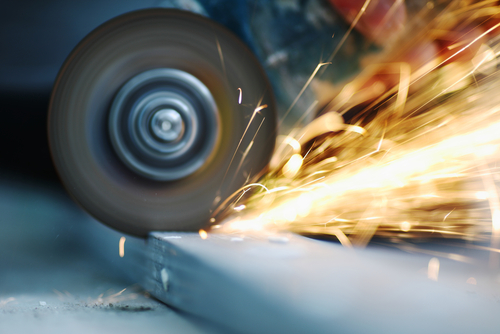Scrap Metal 101: The Spark Test
 When you’re trying to get the best return on your scrap metal, you know that sorting your metal is part of the process to get the best possible scrap price. We’ve discussed a few different tests such as the magnet test, so today we’ll take the sorting process further through the spark test.
When you’re trying to get the best return on your scrap metal, you know that sorting your metal is part of the process to get the best possible scrap price. We’ve discussed a few different tests such as the magnet test, so today we’ll take the sorting process further through the spark test.
Make sure you follow proper safety precautions and use clean equipment when attempting this test – sparks will fly!
Scrap Metal 101: The Spark Test
By looking at the type and direction of spark produced by your metal, you can determine what type of metal you’re sorting. The characteristics you’re looking for are how many sparks are produced, the color of the spark, how long it is and any shape or other form characteristics it may show. You can either put the metal on a grinder or heat a sample up and hit it with compressed air to produce the sparks for testing. Here’s what to look for in different metals:
- Wrought iron sparks tend to go out in a straight line which widen out near the end, somewhat like the shape of a leaf.
- Mild steel sparks can be hard to determine as they are very similar to wrought iron, but there will be tiny forks in the spark and more variation in the length. These sparks will also appear white
- Medium-carbon steel sparks have additional forking than mild steel with a wide variety of spark lengths, concentrated near the grinding wheel.
- High-carbon steel has even more forks, almost forming a bushy pattern starting at the grinding wheel. These sparks are less bright compared to medium-carbon steel.
- Manganese steel produces a medium length spark which will fork twice before dissipating.
- High-speed steel sparks tend to be a faint red with brighter points at the tip.
- 300-series stainless steel produces fewer sparks than carbon steel does. The sparks don’t fork and vary between orange and darker yellow in tone.
- 310-series stainless steel produces sparks that are significantly shorter and skinnier than 300-series stainless steel. The sparks will appear red to orange in color without forking.
- 400-series stainless steel produces similar sparks to the 300-series stainless steel, but the sparks will be a little longer with forks at the spark’s ends.
- Cast iron sparks are quite short and begin at the edge of the grinding wheel.
- High temperature alloys of nickel and cobalt create thin, very short sparks that are dark-red in color, and do not fork.
- Cemented carbide produces sparks that are under 3 inches with a dark-red color and no forking.
- Titanium isn’t a ferrous metal, but it does produce a large number of sparks that are a very brilliant and almost blinding white tone, very different than iron, steel or other ferrous metals.
Now that you have a better idea of what to look for in a spark test, it’s time to sort your scrap. If you need a better visual, take scrap of a known metal and look at the results of the test. This will serve as a benchmark, and allow you to compare your known metal to an unknown metal.
If you have any questions about the spark test or want to scrap metal in Connecticut, please feel free to contact us.

Comments are closed